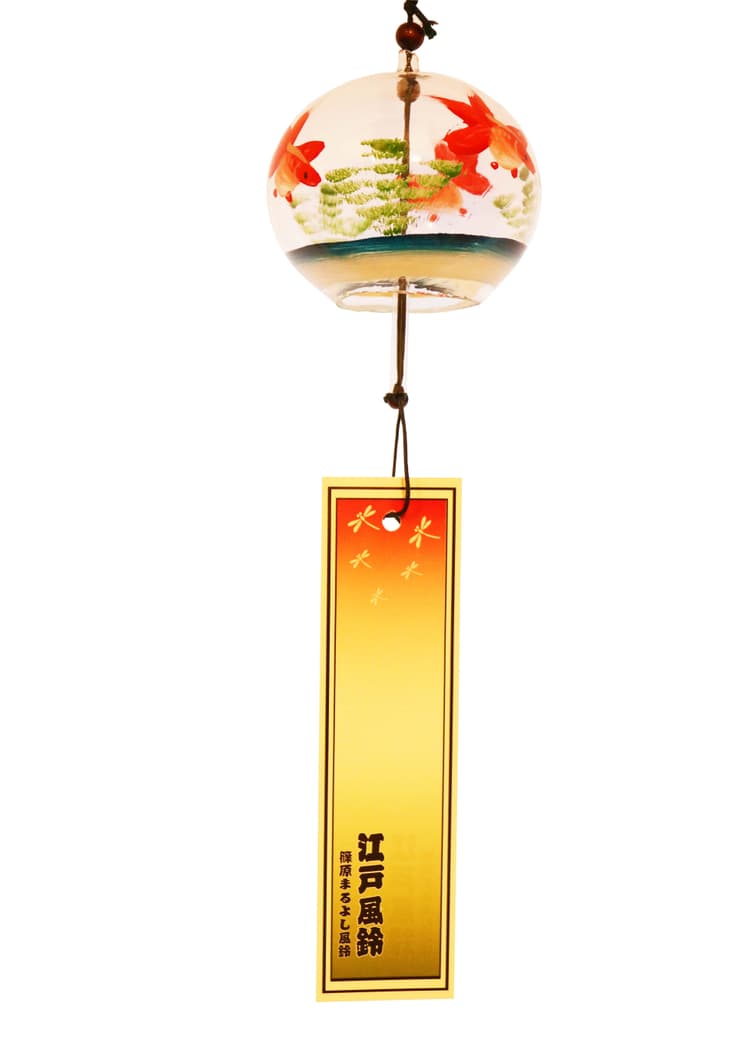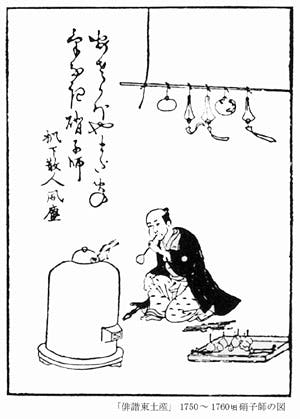The Edo Fuurin
About Edo Fuurin
Edo Fuurin are glass wind chimes that are produced by inheriting the techniques handed down from the Edo period.
It is made by air blowing without using a mold, and all the paintings are painted by craftsmen one by one. There are many kinds of goldfish and fireworks that are perfect for the bright summer, cute sharks and beckoning cats, and each one has auspicious meaning.
The design of the strips mainly produced by Shinohara Maruyoshi Fuurin is vermilion on the top and green on the bottom, showing the blessings of the sun and the prosperity of life on earth.

Making Process
Edo Fuurin are made one by one by craftsmen. First, blow the glass from the wind chime ball, and when the glass ball is made, draw a picture from the inside of the wind chime one by one. It is said that it takes 10 years for a wind chime to blow glass to make a good sound, which is a very difficult technique. Since painting is done from the inside, it is not possible to draw as expected at first, and this is also a technique that requires training for at least 3 years.
Wind chimes are a common glass craft, but they are made by skilled craftsmen.
Wind chimes are a common glass craft, but they are made by skilled craftsmen.
Blow Glass

Wind the glass melted at 1300 ° C into small pieces. This is the ringing part of the wind chime and is called the small glass ball .

Inflate the small glass ball to the size of a 500-yen coin. Be careful to make the thickness even.

Wind the glass over the small glass ball again. This is the wind chime body.

Pour a little air and pass a wire through the center to make a hole. This is a hole for threading.

While preventing the wind chime from bending, take a breath and inflate the main body. This completes the prototype of the wind chime.

After cooling the wind chime, sharpen the part of the small glass ball that was blown first with a whetstone. This will be the jagged mouth!
Check with video
Draw in the WindChime

The craftsman will prepare the oil-based pigments, water-based paints, and brushes needed to paint.

We will carefully write the eyes and patterns of the goldfish with water-based paint with all our heart

Next, I will paint the body color of this goldfish with an oil-based pigment. First, paint the upper part of the body with red and then the belly with white.

After painting the body of the goldfish, write the tail fin, which is the best showcase, vigorously and draw the chest fin.

Next, add a gradation line that represents the water in which the goldfish is swimming, called Mizuhiki.

Finally, draw aquatic plants to prepare the environment for goldfish to live in. This completes the goldfish pattern!
Check with video
History
Birth of Edo Fuurin
The name of the Edo wind chime is `Edo Fuurin` which is a glass wind chime made by the leading person of the road, Yoshiharu Shinohara, one by one. Glass wind chimes, which became known to the common people from the end of the Edo period, were too expensive for the common people to reach before that.
It was worshiped as a rare item among daimyo and wealthy merchants, and was called `Fukoto` and was hung in the room of the mansion. The name of the wind koto was also elegant.
How do you enjoy the hot summer when you don't have a cooler or fan like you do today? ... I created various things with creativity and ingenuity. The `Edo Fuurin` that uses the natural wind is born in it.
In the olden days, in order to fortune-telling one's heart, the `fortune-telling`(fortune-telling by hitting jewels and jewels and fortune-telling with the tone), which was introduced from China, was taken into consideration, but it gradually changed. Things that have nothing to do with the four seasons stand out as a summer tradition. The common people were fascinated by the brilliance of the wind chimes made of transparent glass and the pleasant tone.
It was worshiped as a rare item among daimyo and wealthy merchants, and was called `Fukoto` and was hung in the room of the mansion. The name of the wind koto was also elegant.
How do you enjoy the hot summer when you don't have a cooler or fan like you do today? ... I created various things with creativity and ingenuity. The `Edo Fuurin` that uses the natural wind is born in it.
In the olden days, in order to fortune-telling one's heart, the `fortune-telling`(fortune-telling by hitting jewels and jewels and fortune-telling with the tone), which was introduced from China, was taken into consideration, but it gradually changed. Things that have nothing to do with the four seasons stand out as a summer tradition. The common people were fascinated by the brilliance of the wind chimes made of transparent glass and the pleasant tone.

There are many buyers without a sales voice, but the virtue of wind chimes that can be made into sound
This Kyoka is a poem about the sale of wind chimes at the end of the Edo period. It is said that the wind chimes did not make a selling voice from beginning to end because the wind chimes received a breeze and made a light sound, which is rare for selling goods in this era.
This Kyoka is a poem about the sale of wind chimes at the end of the Edo period. It is said that the wind chimes did not make a selling voice from beginning to end because the wind chimes received a breeze and made a light sound, which is rare for selling goods in this era.

Wind chime as a talisman
It is well known that Japanese people have a strong belief in sound and use `bells` as a talisman. In addition, vermilion (red) has been used as an amulet for a long time, and until the 1970s, vermilion wind chimes were the majority. `Red` was the norm for glass wind chimes. (Since the wind chimes sold around this time do not indicate `Vermilion is a talisman,` it is unknown whether they were bought with the talisman in mind.)
Edo Fuurin have long played a role in healing people's hearts.
Edo Fuurin have long played a role in healing people's hearts.

